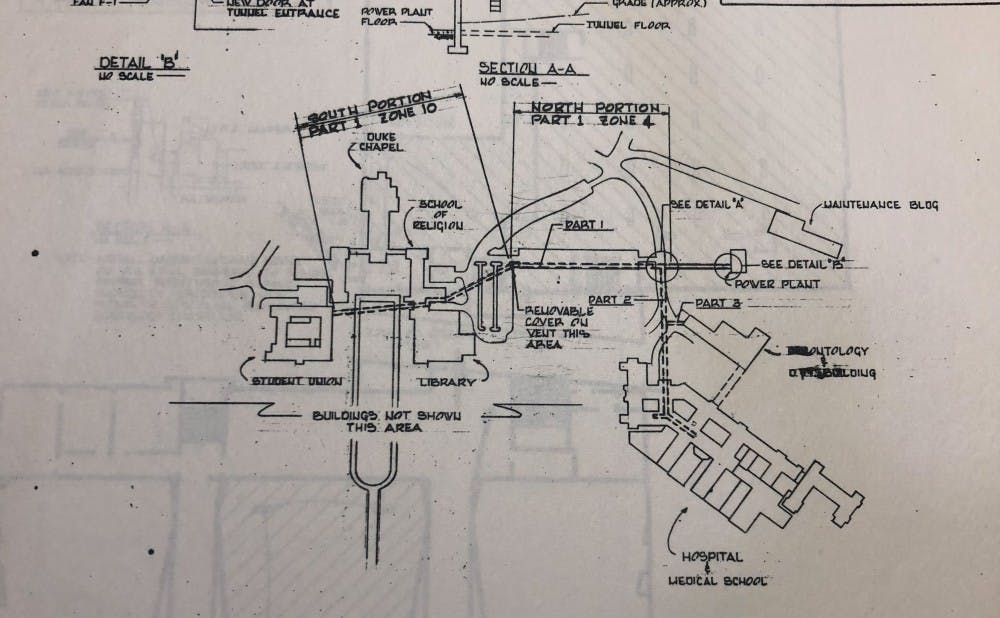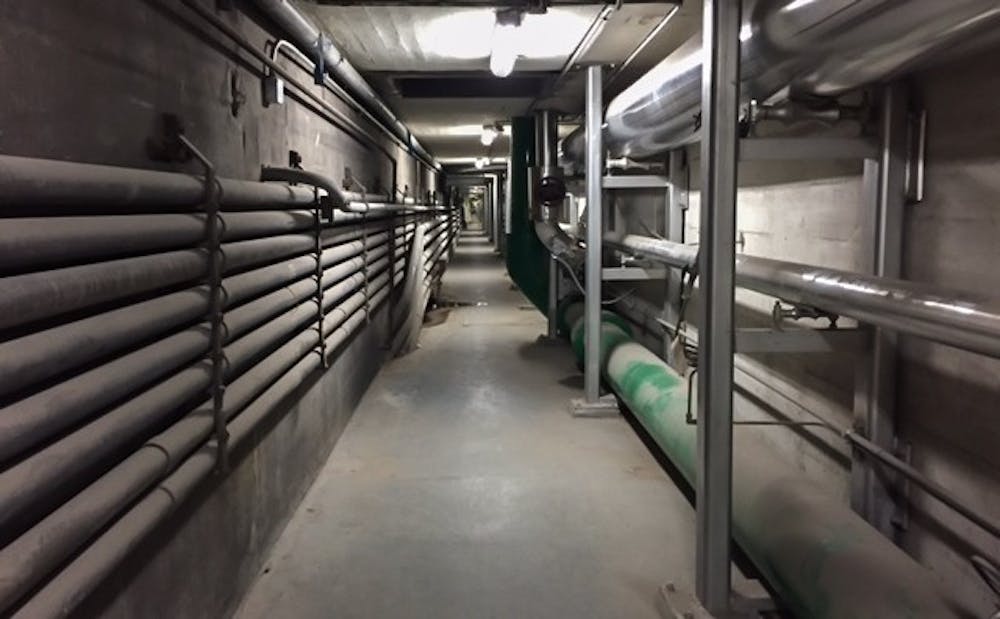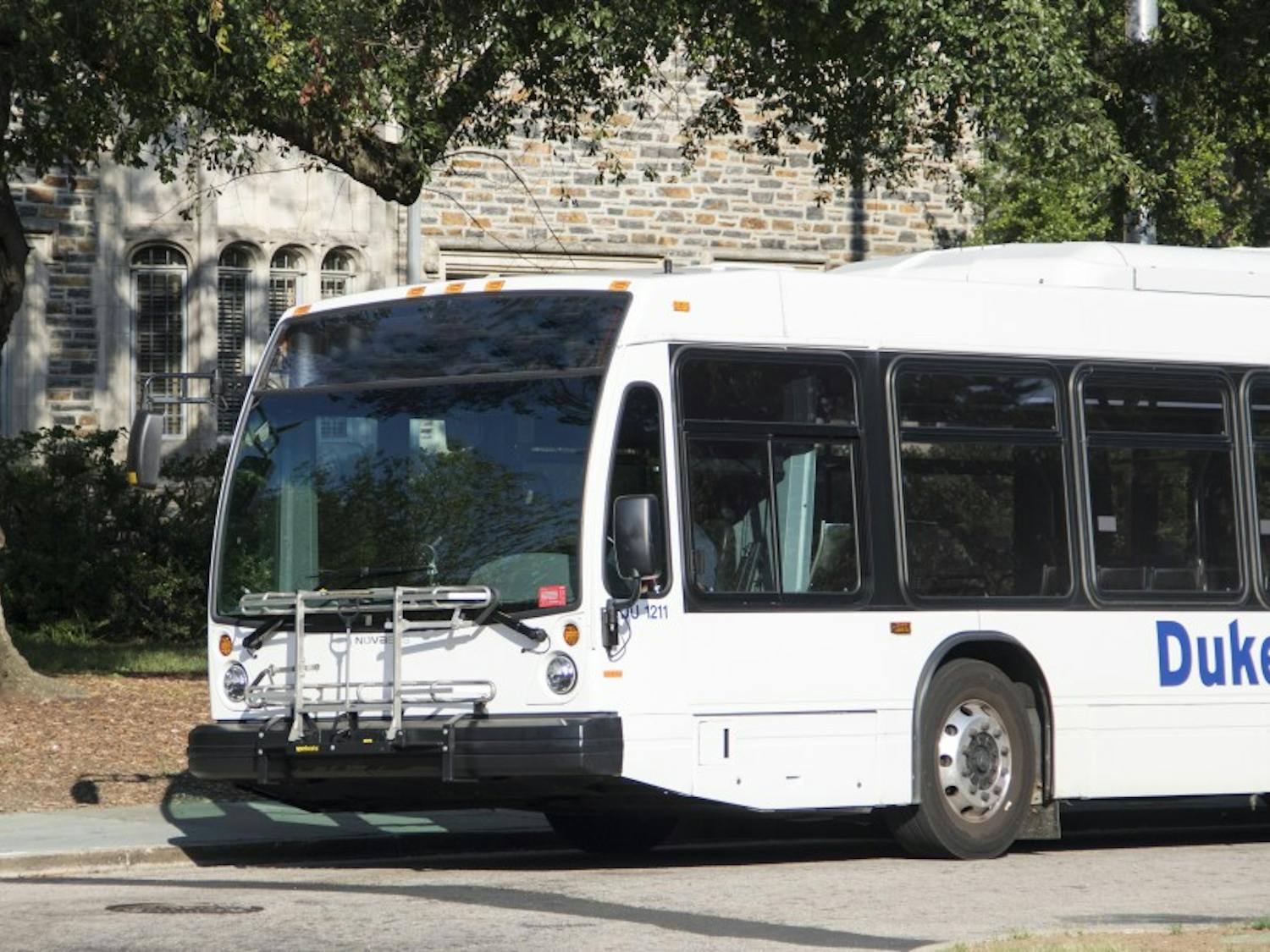Every day, students in the hustle and bustle of class life crisscross campus.
But beneath their feet lies a labyrinth of tunnels—Duke’s very own underworld.
More than a mile of winding passageways in total, the tunnel networks run below both campuses to provide maintenance infrastructure for buildings. The East and West tunnels—built in the mid-1920s and early 1930s, respectively—have had a storied existence, from serving as potential fallout shelters during the Cold War to now serving as an unofficial graduation requirement.
However, students looking to explore the tunnels have to bend the rules to do so, as the Duke Community Standard prohibits student access to the underground labyrinth.
“There really is no big secret down there,” said Mike Snyder, safety manager in the facilities management department. “The bottom line is that there is infrastructure in the tunnel that is dangerous, and we don’t want anyone to get hurt because they go down there exploring or to check off a ‘rite of passage’ block.”
Sue Wasiolek, dean of students and associate vice president for student affairs, knows campus traditions well after roughly 45 years she has spent at Duke as an administrator and student. And during her time at the University, she has heard the curiosity surrounding the tunnels wax and wane.
“There’s a mystique about them, there’s a folklore about them, Duke alums still talk about them,” she said. “I think it’s just natural to want to explore something that is forbidden.”

Stories from those who tunneled
Junior Cade McCurdy is a tunneling veteran, as his expeditions have taken him to the passageways under both East and West Campuses. He has explored the maintenance rooms underneath West more extensively and found a number of random items strewn around the passages, McCurdy wrote in an email to The Chronicle.
In several rooms underneath the dorms, he recounted finding a treasure trove of items presumably left behind by Duke students who have long since graduated.
“There's a ton of clothing in bins, old composites (or whatever those big fraternity photo things are called), pong tables and other assorted junk just lying around,” McCurdy wrote. “I actually have a friend who took a sweatshirt from one of these rooms and wore it around semi-regularly before they graduated.”
Once, McCurdy said he and his friends were exploring the passageways underneath Crowell and Wannamaker after a night out. The group accidentally stumbled upon an entry to the maintenance area that was angled downward and too cramped to fully stand up, so they crawled around 1,000 feet down the narrowly sloped tunnel.
At the end, they found a small room, elevator and another narrow tunnel. When exploring the narrow tunnel resulted in a dead end, the group decided to turn around and head for the exits—but not before one of McCurdy’s friends caught his pants on a pipe.
Attempting to free himself, McCurdy’s friend ripped his pants and was forced to crawl the back up the narrow tunnel wearing only his underwear. He had to shower for nearly 30 minutes to get the grime and dirt of the tunnels off his legs.
One Duke senior, who spoke to The Chronicle under the condition of anonymity due to the illicit nature of tunneling, has made several trips to the East Campus tunnels. He explained that the environment of the tunnels differs based on the time of year.
“It depends on when you go down—in the winter, [it’s] incredibly hot, humid, just kind of miserable,” the senior said.
He also described the labyrinth as claustrophobic, noting that people more than five feet tall have to duck in most spaces to navigate the tunnels comfortably.
One night, he and a group of friends returned from a night out and decided to explore the tunnels beneath East Campus, but they had trouble remembering which window they came in. After wandering through the passageways from around 2:30 to 4:00 a.m., the senior estimated, the group finally managed to get out.
However, some students make less subtle exits. The senior described how a group of friends from his dorm once burst out the emergency exit door of the tunnels, triggering an alarm. Despite the noisy exit, he said that the screeching stopped once the door shut.

Exploration for some, maintenance for others
The tunnels on East Campus run from the steam plant near Smith Warehouse in a loop around the buildings on the main quad, according to a schematic drawn the 1960s by the engineering and architectural firm J.N. Pease and Company.
Extending to West Duke from the steam plant and wrapping around the west side of the quad—running beneath Jarvis, the now-Classroom Building, Giles, Lilly Library, Alspaugh and Pegram—the tunnels quickly jut eastward and turn toward Baldwin Auditorium. After running under Baldwin, the subterranean maze completes the loop by connecting Bassett, Brown, Marketplace, Wilson, Friedl, East House and East Duke to the point underneath West Duke.
Snyder explained the East tunnels stretch on for slightly less than a mile, whereas the West passageways run for around four-tenths of a mile. West Campus tunnels originate from the power plant along Research Drive and form two branches—one runs south and terminates underneath Duke Medical Center, and the other travels underneath Perkins Library and the Divinity School to the Brodhead Center.
There are also some mechanical rooms located underneath West Campus dorms, Snyder added, which are not connected to the tunnels running from the steam plant.
However, the fabled tunnel that connects East and West does not exist and is merely a steam line.
Wasiolek explained she was first exposed to the tunnels while living as a resident assistant in East Residence Hall. When she would go to the dorm basement to do her laundry, she was able to peer into an area leading to the tunnels—though she never tried to follow the pathway.
Nowadays, due to increased security measures, students heading downstairs to do laundry wouldn’t be able to sneak a glimpse into the tunnels as Wasiolek could in the 1970s.
She said that conversation about student tunneling grew once she took a Student Affairs job in 1979, and that the 1980s and 1990s were the peak of tunneling frenzy. Wasiolek noted that there are currently around two to four students caught per year—and none in some years—compared eight to 12 students each year at the height of tunneling.
“I think there are still conversations about it, I think it still appears on graduation requirement lists, but for me, it has not been in the forefront of students’ minds in the same way that it has been in the past,” she said.
McCurdy agreed that few students actively explore the tunnels. In most cases, students accidentally discover an access point before briefly exploring and documenting the experience on Snapchat, he explained.
Wasiolek attributed some of the decline to increased security measures—such as cameras in the tunnels—that prevent student access and catch explorers in the act.
When students are caught or observed tunneling, Wasiolek said that Duke Police sends a report to the Office of Student Conduct if the culprits were identifiable. From there, the students meet with a member of the Student Conduct office to determine their punishment.
“Depending on the students’ cooperation and the students’ prior disciplinary record, those things will all be taken into consideration when sanctioning the student,” Wasiolek said. “The student could be given as little as an admonition—don’t do it again—or a more formal written warning or probation.”
Although Wasiolek could not recall a student who had been suspended for tunneling, she explained that a suspension would not be out of line for those with an extensive University disciplinary record.
The tunnels’ danger is the primary reason they remain off limit to students, Snyder said. He explained that the passageways serve as a way of housing high-voltage, low-voltage, steam and plumbing infrastructure for buildings on both campuses.
“They are used every day by maintenance workers or by contractors, particularly during any kind of renovation or new construction,” Synder said. “For example, maintenance workers will repair steam leaks, repair or replace light bulbs or fixtures, update equipment and make plumbing repairs.”
Anyone who enters the tunnels must attend a class to learn about the safety procedures and wear protective equipment to protect them from high-voltage equipment and other potential dangers.
Snyder mentioned that the tunnels contain asbestos—a carcinogenic insulating material—which workers must learn to recognize and avoid.
“I would venture to say that most students probably don’t recognize what asbestos is if they saw it or what products it’s contained in,” he said.
Fallout shelters
If a nuclear weapon had struck the United States during the Cold War, it was possible that the tunnels could have been pressed into service for a far more grim purpose.

Duke convened a Fallout Preparedness Committee in the early 1960s to plan a shelter capable of housing 25,000 Duke-affiliated students and personnel. As an underground connection linking a number of buildings on West and East Campus, the tunnels were on the minds of those tasked with making fallout plans.
“Furthermore, the buildings designated [as fallout shelters] are all interconnected by a tunnel system which houses water pipes, electricity, etc… and which provides walking space in most instances between buildings,” the committee wrote in a March 1962 report.
Although the fallout plans were drawn up to shelter most people on West, a committee report also mentioned the East Campus tunnels as a potential option for housing. The committee wrote that the East tunnels “have a total area of 45,000 square feet, sufficient to house 4,500 people at 10 square feet each.”
By March 1963, when the Fallout Preparedness Committee recommended taking advantage of the tunnels for more emergency preparedness initiatives. The Subcommittee on Engineering and Construction wrote that $25,000 should be directed to “extend emergency light circuits into the tunnels.” The subcommittee also proposed expanding the tunnels to connect more buildings.
Finding tradition
Ultimately, Wasiolek explained that she views tunneling as an attempt to establish a Duke-specific tradition.
“Some people will say that K-Ville is a tradition, that [the Last Day of Classes celebration] is a tradition—there are these graduation requirements that have been a little squishy over the years,” she said. “But I don’t think we are this tradition-rich institution. And when that conversation emerges, tunneling seems to come up.”
McCurdy attributed student fascination with the tunnels to an “allure of the unknown and social media clout.”
“I think the allure of the unknown is fairly self-explanatory, as people find these cool tunnels they've never been in and can't help but give it at least a cursory investigation,” he wrote.
The lore surrounding the tunnels is unmistakable. Tunnel-related rumors abound—past articles from The Chronicle have quoted University personnel claiming that stray cats and dogs call the tunnels home, raising their litters in the labyrinth under campus.
Wasiolek mentioned that she has heard many tales over the years, including one about students who were chased by a police officer through the tunnels, those who sprinted out after discovering the rot and decay of dead animals and another story about students who would bring food to the tunnels and have a meal there.
Regardless of whether this lore is true, it emphasizes the fascination students have with bending the rules for the sake of adventure and tradition.
“It’s human nature for things that are forbidden to somehow be more alluring,” she said. “Maybe if we just opened the tunnels and did tours on a regular basis, people would completely lose interest in them.”




